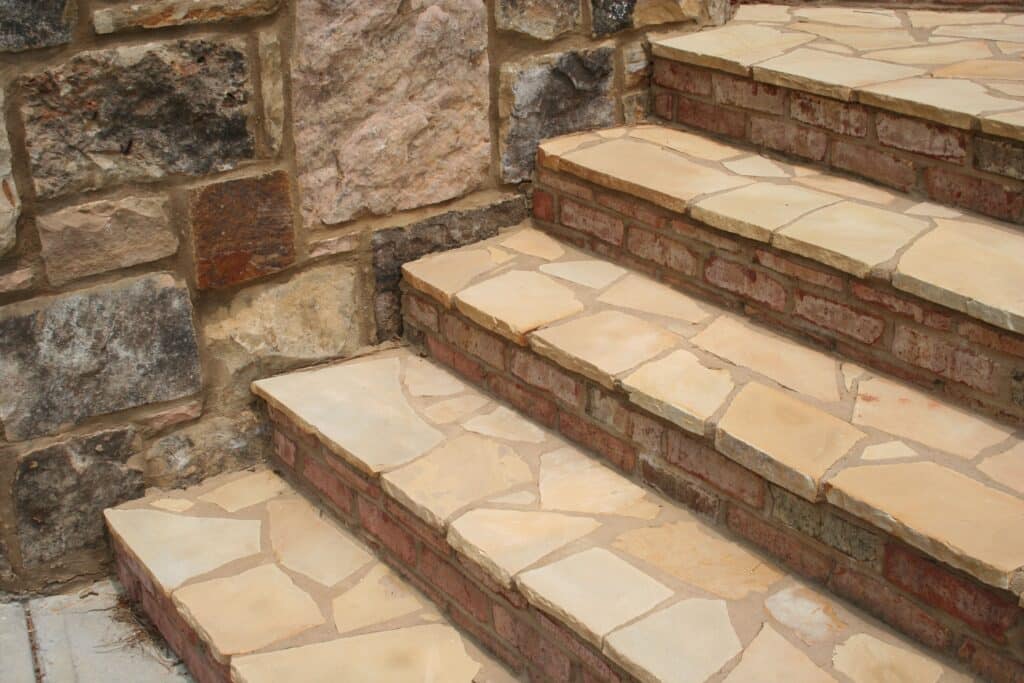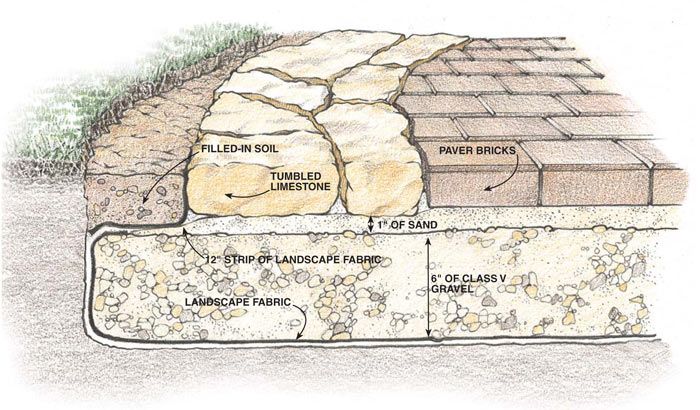
Flagstone ni mojawapo ya mawe ya gorofa yanayotumika sana. Inachukuliwa kuwa kisambazaji bora endelevu cha uhalisi katika muundo wako wa mlalo.
Sababu ya kushawishi nyuma ya hii ni wakati unatumia gorofa hizi mawe, utaunda hisia iliyofanywa kwa mkono kwenye yadi yako ambayo pia inaonekana isiyo na wakati. Ingawa kuna tofauti nyingi za mawe ya kisasa na ya kukata rustic, unaweza kuleta ladha na mtindo wako binafsi.
In this blog, you will first get to know the origins of this flagstone and learn about its creation. Afterward, you’ll learn about the different types and the best practices for using them. At length, you’ll gain valuable knowledge in the art and science of installing this material.
Flagstone is a generic term for many different types of rock. In the beginning, a stonemason chisels or strikes larger stones. And as a result, it breaks up into thick, flat sheets. Next, these thinner sheets are then broken up into flagstone-sized pieces. There are abundant varieties of rock that masons cut and then shape into flagstones.
Hapo awali, mawe laini na rahisi zaidi kutengeneza patasi ni miamba ya mchanga, ikijumuisha aina kama vile mchanga, shale na chokaa.
Pili, aina ngumu zaidi ni pamoja na miamba ya moto kama vile granite au basalt. Hatimaye, aina ngumu zaidi ni za miamba ya metamorphic, kama vile quartzite na pia marumaru.
Kuna aina mbili kuu za mahitaji Flagstones: patio and select. Comparatively, Patio pieces type of Flagstone is smaller, ranging from 12” to 18” and thicker. And are most often used for stepping stones, outdoor pathways, or patios. Due to their smaller size, they are typically palletized lying down, preventing breakage during shipment. Contrarily, select flagstone, known as “standup,” comes in large, thin slabs of 18” to 36”. Due to their large size, they are usually palletized vertically. Flagstones generally make the formation of many shapes and sizes, including rectangular and square. Nevertheless, they are also available in more natural, jagged varieties.

For more than hundreds of thousands of years, Flagstone has been used in various types of formation. Earlier in the 1900s, people saw it as an improvement over cobblestone, and it’s easy to see why. Whereas stonemasons can chisel it at ease by hand into a very flat surface, it is a simple way to create a flat paving surface. Its notable usages as countertop material or even as a paving substrate and as a walkway or roadway. People even use them as roofing and siding. Flagstone patios and Stepping stones are the most common applications of flagstones.

Kwa kawaida sisi hutumia mchanga kama nyenzo ya msingi kwa mawe ya bendera. Kwanza, Sand ni rahisi sana kusakinisha na inatoa faida kubwa ya mifereji ya maji. Mbali na hilo, pia zitasaidia kuzuia magugu na ukuaji wa mimea kati ya mawe yako kama matokeo. Hata hivyo, kwa ajili ya ufungaji wa kudumu zaidi, tumia saruji. Kwa msingi wa mchanga, utahitaji jiwe nene la bendera. Chokaa pia hukuruhusu kutumia mawe nyembamba kwani msingi wa saruji husaidia kuimarisha uso.

Jambo bora zaidi juu ya jiwe hili la asili ni kwamba unaweza kuunda ili kuunda mifumo mingi tofauti, ya kipekee! Vivyo hivyo, kikomo pekee ni mawazo yako na nyenzo hii. Ili kusimbua taswira yako, kwa kweli, unachohitaji kufanya ni kuunganisha mlalo wako pamoja. Hii ni mantiki kwamba ikiwa unataka kuangalia kisasa, safi, unahitaji kuhakikisha kushikamana na muundo mkali zaidi, unaorudia. Kwa upande mwingine, unaweza kwenda kwa ukubwa usio wa kawaida na maumbo ya random kwa kuangalia rustic na asili.

Unaweza kupenda mawe ya bendera kwa sababu nyingi, pamoja na, Mawe ya bendera which are naturally flat, and it’s easy to use in so many different projects.
However, because flagstone is more of a generic term for many sedimentary rocks, it’s easy to misunderstand and underappreciate.
Hapa kuna baadhi ya mambo unapaswa kujua kuhusu:
Flagstone’s one of the beneficial advantages is that it’s relatively flat when mined, making it ideal in so many landscaping projects.
Second, it’s naturally non-slip. Whenever you are all set to starting a project where people will need to walk, a non-slip surface is essential for safety. Next, it’s strong and stable. When installed properly, it won’t break or crack.
Kwa ujumla, unaweza kupata wigo mbalimbali au hues ya Mawe ya bendera na tumia vivuli vyovyote. Ingawa wengi wana vivuli vya kijivu au hudhurungi kama miamba mingi, vivuli vingi vinaweza kuwa na waridi, kijani kibichi, bluu, dhahabu, na hata karibu na nyeupe.
Inamaanisha kuwa unaweza kupata na kuchagua jiwe la bendera ambalo linaweza kulisaidia au kulitofautisha, haijalishi lengo lako ni lipi, bila kujali ni rangi gani ambazo tayari zinatumika kuzunguka nyumba yako.
Hasa, unaweza kupata mchanganyiko rahisi wa mawe na rangi nyingi na kuunda patio moja ya aina au njia ya kutembea pia.
Kubadilika kwa usakinishaji kunaweza pia kuzingatiwa kama moja ya faida zake nyingi. Ili kuweka patio, unaweza kutaka kuzingatia kuiweka na chokaa kati ya mawe. Hii hakika itatoa patio yako kiwango kabisa na hisia dhabiti, bora kwa viti na meza.
Suppose you’re planning to construct a walkway across your lawn. You can install large stones directly on your dirt and install mulch or allow the grass to grow around it.
As an alternate, you can also create a walking path with gravel between the stones. It’s also a great option for building stairs. Nevertheless, you would want to use cement to ensure safety and stability.
From our long-entailed informative blog, we hope we have provided you a clear conception of how, no matter what project you’re planning, there are ways to incorporate this beautiful stone.